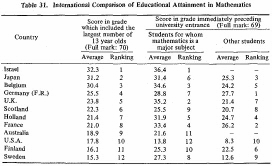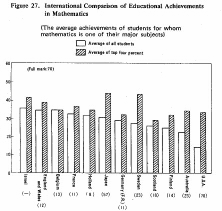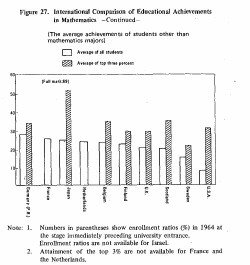| Home > Policy > White Paper, Notice, Announcement > White Paper > EDUCATIONAL STANDARDS IN JAPAN 1971 > CHAPTER |
||
The aim of this section is to make an international comparison of educational achievements in mathematics based on the results of the International Study of Educational Attainment (TEA) conducted in 1964 under the leadership of the Unesco Institute for Education, Hamburg.
In terms of educational achievements in the grade having the highest proportion of thirteen year old pupils (the second grade of lower secondary schools in Japan) Japan ranked second to Israel among the twelve countries which participated in this project. As for students at the stage immediately preceding university entrance (the third grade of Upper secondary schools in Japan), those students for whom mathematics is a major subject (in the case of Japan, students who completed not less than five credits of 'mathematics III' or 'applied mathematics') ranked sixth among the twelve countries, and non-mathematics majors ranked third among ten countries.

These rankings may be affected by differences in enrollment ratios. In Figure 27, in order to control for this factor, the educational achievements of the top 3 or 4% Of students in the age group corresponding to the stage prior to university entrance is compared. According to this method of comparison, the average attainment of Japan can be ranked in first place.
These figures all show that the educational attainment in mathematics in Japan is high on the average. But the attainment by individual students varies widely. This may be due to the comparatively high enrollment ratio in Japan. However, this suggests the necessity to provide a wide variety of curriculum in the future for those students with scholastic achievements widely different from one another. The analysis of educational attainments by instructional area also reveals that achievements in areas related to mathematical thinking were inferior in Japan to those in the other paricipating countries. Therefore, improvement of this aspect of education is a task to be tackled in the future.


Note: 1. Numbers in parentheses show enrollment ratios (%) in 1964 at the stage immediately preceding university entrance.
Enrollment ratios are not available for Israel.
2. Attainment Of the top 3% are not available for France and the Netherlands.
| Back to Top | MEXT HOME |